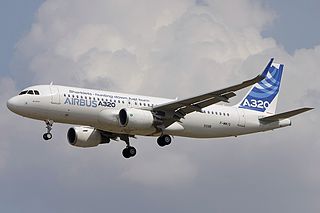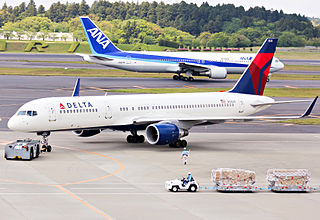
An aerospace manufacturer is a company or individual involved in the various aspects of designing, building, testing, selling, and maintaining aircraft, aircraft parts, missiles, rockets, or spacecraft. Aerospace is a high technology industry.

The Airbus A320 family is a series of narrow-body airliners developed and produced by Airbus. The A320 was launched in March 1984, first flew on 22 February 1987, and was introduced in April 1988 by Air France. The first member of the family was followed by the longer A321, the shorter A319, and the even shorter A318 . Final assembly takes place in Toulouse in France; Hamburg in Germany; Tianjin in China since 2009; and Mobile, Alabama in the United States since April 2016.

The Airbus A340 is a long-range, wide-body passenger airliner that was developed and produced by Airbus. In the mid-1970s, Airbus conceived several derivatives of the A300, its first airliner, and developed the A340 quadjet in parallel with the A330 twinjet. In June 1987, Airbus launched both designs with their first orders and the A340-300 took its maiden flight on 25 October 1991. It was certified along with the A340-200 on 22 December 1992 and both versions entered service in March 1993 with launch customers Lufthansa and Air France. The larger A340-500/600 were launched on 8 December 1997; the A340-600 flew for the first time on 23 April 2001 and entered service on 1 August 2002.

The Airbus A380 is a very large wide-body airliner that was developed and produced by Airbus. It is the world's largest passenger airliner and the only full-length double-deck jet airliner. Airbus studies started in 1988, and the project was announced in 1990 to challenge the dominance of the Boeing 747 in the long-haul market. The then-designated A3XX project was presented in 1994; Airbus launched the €9.5–billion ($10.7–billion) A380 programme on 19 December 2000. The first prototype was unveiled in Toulouse on 18 January 2005, with its first flight on 27 April 2005. It then obtained its type certificate from the European Aviation Safety Agency (EASA) and the US Federal Aviation Administration (FAA) on 12 December 2006.

The Airbus A318 is the smallest and least numerous variant airliner of the Airbus A320 family. The A318 carries 107 to 132 passengers and has a maximum range of 5,750 kilometres. Final assembly of the aircraft took place in Hamburg, Germany. It is intended primarily for short-range service.

The CFM International CFM56 series is a Franco-American family of high-bypass turbofan aircraft engines made by CFM International (CFMI), with a thrust range of 18,500 to 34,000 lbf. CFMI is a 50–50 joint-owned company of Safran Aircraft Engines of France, and GE Aerospace (GE) of the United States. GE produces the high-pressure compressor, combustor, and high-pressure turbine, Safran manufactures the fan, gearbox, exhaust and the low-pressure turbine, and some components are made by Avio of Italy and Honeywell from the US. Both companies have their own final assembly line, GE in Evendale, Ohio, and Safran in Villaroche, France. The engine initially had extremely slow sales but has gone on to become the most used turbofan aircraft engine in the world.

CFM International is a Franco-American aircraft engine manufacturer. The company is a joint venture between GE Aerospace and Safran Aircraft Engines and is headquartered in Cincinnati, Ohio. It was founded in 1974 to build and support the CFM56 series of turbofan engines. CFM is the world's largest commercial aircraft engine manufacturer, with a 39% market share as of 2020. It has delivered more than 37,500 of its engines to more than 570 operators. The name CFM is derived from the two parent companies' commercial engine designations: GE's CF series and Snecma's M series.

Safran Aircraft Engines, previously Snecma or Snecma Moteurs, is a French aerospace engine manufacturer headquartered in Courcouronnes and a subsidiary of Safran. It designs, manufactures and maintains engines for commercial and military aircraft as well as rocket engines for launch vehicles and satellites.

Aircraft maintenance checks are periodic inspections that have to be done on all commercial and civil aircraft after a certain amount of time or usage. Military aircraft normally follow specific maintenance programmes which may, or may not, be similar to those of commercial and civil operators.

The Rolls-Royce Trent 800 is a high-bypass turbofan produced by Rolls-Royce plc, one of the engine options for the early Boeing 777 variants. Launched in September 1991, it first ran in September 1993, was granted EASA certification on 27 January 1995, and entered service in 1996. It reached a 40% market share, ahead of the competing PW4000 and GE90, and the last Trent 800-powered 777 was delivered in 2010. The Trent 800 has the Trent family three shaft architecture, with a 280 cm (110 in) fan. With a 6.4:1 bypass ratio and an overall pressure ratio reaching 40.7:1, it generates up to 413.4 kN of thrust.

The Rolls-Royce Trent 1000 is a high-bypass turbofan engine produced by Rolls-Royce, one of the two engine options for the Boeing 787 Dreamliner, competing with the General Electric GEnx. It first ran on 14 February 2006 and first flew on 18 June 2007 before a joint EASA/FAA certification on 7 August 2007 and entered service on 26 October 2011. Corrosion-related fatigue cracking of intermediate pressure (IP) turbine blades was discovered in early 2016, grounding up to 44 aircraft and costing Rolls-Royce at least £1.3 billion.

Jat Tehnika is a Serbian aerospace company providing aircraft maintenance, repair and overhaul. The company is based at Belgrade Nikola Tesla Airport and provides services for Air Serbia and other airlines across Europe.
TAP Maintenance & Engineering – the maintenance, repair and operations center of TAP Air Portugal airline – is located at Portela Airport, Lisbon, Portugal.

The Pratt & Whitney PW1000G family, also known as the GTF, is high-bypass geared turbofan produced by Pratt & Whitney. Following years of development and testing on various demonstrators, the program officially launched in 2008 with the PW1200G destined for the Mitsubishi SpaceJet. The first successful flight test occurred later that year. The PW1500G variant, designed for the Airbus A220, became the first certified engine in 2013. The program cost is estimated at $10 billion.

FL Technics is a global provider of aircraft maintenance, repair and overhaul (MRO) services, headquartered in Vilnius, Lithuania. The company has Base Maintenance facilities in Lithuania and Indonesia and provides Line Maintenance support across Europe, Africa and Asia-Pacific.

The Airbus A320neo family is an incremental development of the A320 family of narrow-body airliners produced by Airbus. The A320neo family is based on the previous A319, A320, and A321, which was then retrospectively renamed the A320ceo family.

Delta TechOps is the maintenance, repair and overhaul (MRO) division of Delta Air Lines, headquartered at Hartsfield-Jackson International Airport in Atlanta, Georgia. With more than 9,600 employees and 51 maintenance stations worldwide, Delta TechOps is a full-service maintenance provider for the more than 900 aircraft that make up the Delta Air Lines fleet. In addition to maintaining the Delta Air Lines fleet, Delta TechOps also provides MRO solutions and support to more than 150 third-party operators around the world, making it the second largest MRO provider in North America and the seventh largest worldwide.

AerSale, Inc. is a Doral, Florida-based global supplier of aftermarket commercial jet aircraft, engines, used serviceable materials, and aeronautical engineering services to passenger and cargo airlines, government entities, leasing companies, multinational OEMs, and independent MROs.

The New Midsize Airplane (NMA), or New Midsize Aircraft, is a concept airliner proposed by Boeing to fill the middle of the market segment.
This is a list of aviation-related events in 2018.























